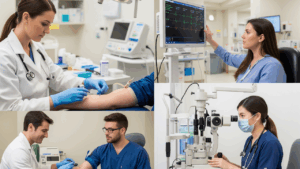
Summary (Key Takeaways)
- A Clinical Medical Assistant specializes in direct patient care, such as taking vitals, injections, blood draws, and assisting in procedures.
- Both certifications are valued; CMA offers a broad skill set,and CCMA focuses more on clinical tasks.
- Medical assisting is projected to grow 15% (2023–2033) with a median salary of $44,200/year.
- Clinical MAs work in outpatient clinics, specialty offices, and hospitals’ outpatient departments.
- Many MAs advance to lead positions, nursing roles, or specialized healthcare certifications.
- Pay is highest in states like CA, MA, WA; strong demand in Texas and other southern states.
Healthcare continues to be one of the fastest-growing industries in the U.S., and Clinical Medical Assistants play a crucial role in keeping clinics and outpatient centers running efficiently.
According to the U.S. Bureau of Labor Statistics, employment of medical assistants is projected to grow 15% from 2023 to 2033 — much faster than the average for all occupations — with a median annual wage of $44,200 as of May 2024.
In this guide, we’ll explore exactly what a Clinical Medical Assistant is, what they do, how they differ from other healthcare roles, pay ranges by state, certification options, and the career paths that open up once you start in this field.
What Does a Clinical Medical Assistant Do?
A Clinical Medical Assistant is trained to handle the “back-office” clinical duties in a healthcare setting. While some MAs perform both administrative and clinical work, a clinical MA focuses mainly on patient care.
Typical Duties
- Take vital signs (blood pressure, pulse, temperature, weight, height).
- Record medical histories in the patient’s chart/EHR.
- Prepare patients for exams and procedures.
- Assist physicians during exams or minor surgeries.
- Draw blood (phlebotomy) and collect lab specimens.
- Administer medications/injections (as permitted by state law).
- Perform EKGs and other diagnostic tests.
- Educate patients about treatments, medication use, and aftercare.
- Sterilize instruments and maintain infection control.
For details on how CCI Training prepares you for these skills, see our Medical Assistant Program page.
Clinical Medical Assistant vs Medical Assistant
While all medical assistants receive basic clinical training, “Clinical Medical Assistant” indicates a role that is patient-care focused.
| Aspect | Medical Assistant (General) | Clinical Medical Assistant |
| Primary Duties | Mix of admin & clinical tasks | Mostly clinical tasks with minimal admin work |
| Work Location | Front desk & exam rooms | Exam rooms, labs, procedure areas |
| Skills Emphasis | Billing, scheduling, vitals, injections | Vitals, phlebotomy, injections, assisting in exams |
| Certification | CMA, CCMA, RMA, NCMA | Usually CCMA or CMA with clinical emphasis |
CMA vs CCMA: Which is Better?
Two top certifications are:
- CMA (Certified Medical Assistant) — from AAMA, requires an accredited program; covers both clinical & admin skills.
- CCMA (Certified Clinical Medical Assistant) — from NHA, flexible eligibility; stronger clinical focus.
Pay: No major salary difference between CMA and CCMA — being certified at all is what increases your earning potential (often 5–15% more than non-certified).
Pro Tip: Choose the cert your school prepares you for. Both are nationally recognized.
Salary & Job Outlook
National Pay Data
- Median pay: $44,200/year (~$21/hour).
- Top 10% earners: $55k–$56k/year.
- Entry-level: $35,000–$38,000/year; increases with experience and specialization.
Day in the Life of a Clinical Medical Assistant
A typical day may include:
- Preparing exam rooms and reviewing patient charts.
- Greeting patients and collecting vital signs.
- Assisting the physician during examinations.
- Drawing blood samples and administering injections.
- Educating patients about medications or aftercare instructions.
- Updating electronic health records (EHR).
- Restocking medical supplies and maintaining sterilization standards.
Clinical Medical Assistant vs CNA
When considering a career in healthcare, understanding the differences between roles like Clinical Medical Assistants and Certified Nursing Assistants (CNAs) is crucial. Below, we break down the key distinctions in responsibilities, training, and more to help you make an informed decision.
| Aspect | CNA (Certified Nursing Assistant) | Clinical MA |
| Primary Work | Bedside care in hospitals/nursing homes | Outpatient patient care in clinics |
| Duties | Bathing, feeding, lifting patients | Vitals, injections, lab tests |
| Training | 4–12 weeks | 6–12 months |
| Supervision | RNs/LPNs | Physicians/NPs/PAs |
| Pay | ~$39,000 avg | ~$44,000 avg |
Where Clinical Medical Assistants Work
- Primary Care Offices: Family medicine, internal medicine practices.
- Specialty Clinics: Cardiology, dermatology, pediatrics, OB/GYN.
- Outpatient Centers: Surgical centers, urgent care facilities.
- Public Health Clinics: Community health centers serving underserved populations.
Skills Every Clinical Medical Assistant Should Master
- Clinical Accuracy: Taking precise vitals and measurements.
- Communication Skills: Explaining procedures and care plans clearly.
- Technical Proficiency: Operating EKG machines, autoclaves, and lab equipment.
- Time Management: Handling multiple patients and tasks efficiently.
- Team Collaboration: Working closely with doctors, nurses, and other staff.
Challenges Faced by Clinical Medical Assistants
While rewarding, the role can be demanding:
- Fast-Paced Work Environment: Handling back-to-back patients and urgent tasks.
- Emotional Demands: Supporting anxious or unwell patients compassionately.
- Physical Requirements: Standing for long periods, moving between exam rooms.
- Adaptability: Switching between clinical duties and occasional administrative needs.
Emerging Trends in Clinical Medical Assisting
- Telehealth Support: Assisting with virtual patient consultations and remote monitoring.
- Expanded Skill Sets: More clinics are training MAs in specialized procedures.
- Electronic Health Record Mastery: High demand for EHR-proficient MAs.
- Preventive Care Focus: Increased role in wellness programs and patient education.
Career Advancement Paths
- Lead MA / MA Supervisor — oversee staff in larger clinics.
- Specialization — ophthalmology, dermatology, cardiology.
- Nursing — bridge to LPN or RN programs.
- Allied Health — transition to radiology tech, respiratory therapist, etc.
- Administration — office manager, medical billing, or health information roles.
Tips for Success as a Clinical Medical Assistant
To excel in clinical medical assisting, focus on building both technical and interpersonal skills.
Key Success Tips:
- Stay Organized: Manage patient flow and documentation efficiently.
- Be Compassionate: Patient care is as much about empathy as clinical skill.
- Master Technology: Be proficient with EHR systems and diagnostic equipment.
- Pursue Specializations: Adding phlebotomy, EKG, or bilingual skills can increase your value.
- Network in Healthcare: Build relationships with nurses, doctors, and other MAs to open career opportunities.
Conclusion
Becoming a Clinical Medical Assistant is a fast, affordable path into healthcare, offering hands-on patient care, steady demand, and career mobility. With CCI Training’s flexible programs, you can become job-ready in as little as 6–8 months, equipped to take national certification exams and start a stable, rewarding career.
Learn more about the Medical Assistant Program at CCI Training and take your first step toward a career where compassion meets skill
Program Offered
- Pharmacy Technician Training
- Online Medical Assistant
- Medical Billing and Coding Specialist Program
- Cloud Computing Technician Training
- Computer Network Technician
- Business and Accounting
- Radiology Technician Training
- Medical Assistant Program
- Computer Support Technician
- Cybersecurity Program
- Virtual Assistant Training

This article is written by
Share this article
Frequently Asked Questions FAQ's
What is a Clinical Medical Assistant?
A healthcare professional focused on clinical duties like vitals, injections, lab work, and assisting doctors in outpatient settings.
CMA vs CCMA — Which is better?
Both are respected; choose based on your program eligibility and whether you want a clinical emphasis (CCMA) or broader scope (CMA).
Is a Clinical Medical Assistant higher than a CNA?
CMAs generally have a broader scope and higher pay; CNAs focus on bedside care in inpatient facilities.
Can a CCMA draw blood?
Yes — most CCMA programs include phlebotomy training.
What’s the highest pay for a Medical Assistant?
Top earners make $55k–$56k/year; higher in states like CA, MA, WA, and in specialized clinics.
Related Articles


















